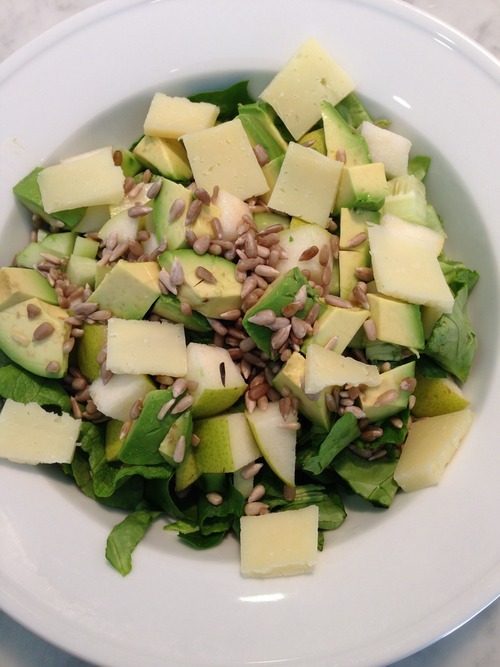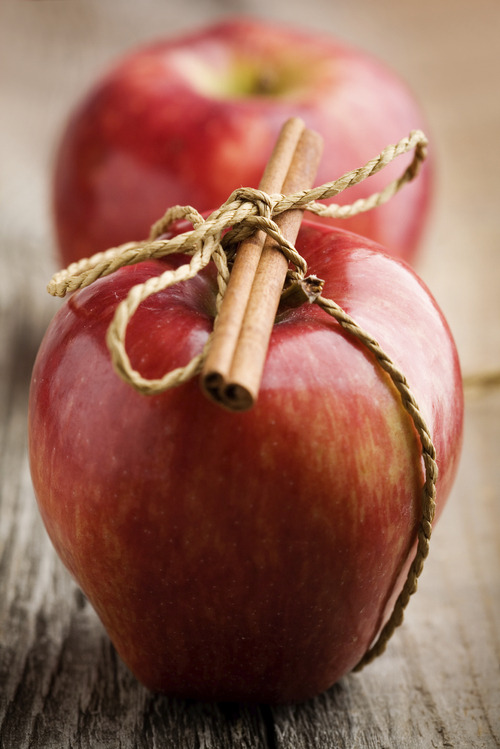Anyone who knows me well knows I don’t particularly like sandwiches. It’s not that I won’t eat them, but if given the choice of a sandwich or something else, I will usually choose something else… which means I have to be creative sometimes. Do you ever have those days where you are hungry and don’t know what you feel like eating? That was me one day last week. I stood staring into the open refrigerator, feeling hungry, but not exactly sure what I was looking for. What I did see were lot of “parts”. I pulled them out one by one… green leaf lettuce, spinach, ½ of a leftover avocado, sprouted sunflower seeds, cucumber, a ripe pear and some Manchego cheese. Hmm… looked like a great salad was about to come together.
I recently Instagramed a picture of this thrown together salad I nicknamed the Green Goddess Salad and I received a lot of requests for the recipe. There isn’t an exact recipe, but salads are forgiving that way. Cut up what you have, toss in a bowl with some ‘clean’ dressing and you’ve got lunch. Maybe you have some pomegranate seeds or red peppers to add? Or leftover roasted vegetables to add to the mix? Focus on adding in produce and keep the cheese and nuts to a minimum. And you probably noticed I didn’t use croutons… it’s best to get your crunch from the nuts or veggies, like celery or jicama. The next time you’re staring in your fridge trying to decide what to eat, pull out your veggies and fruits and throw a salad together. I’d love to hear what your final creation has in it. Enjoy!
The ingredients and their nutritional ‘umph’ from my Green Goddess Salad are listed below.
Salad Ingredients (60% lettuces, 40% add-in ingredients)
Spinach
Green Leaf Lettuce
Cucumber
Pear
Avocado
Sprouted Sunflower Seeds (or substitute with raw sunflower seeds)
Manchego cheese (small amount)
The Dressing - Apple Cider Vinaigrette
(whisk the ingredients in a small container – all amounts are approximate - adjust amounts to your personal taste. Leftover dressing keeps well in a small canning jar)
3 TBSP Apple Cider Vinegar
¼ Cup Extra Virgin Olive Oil
1 tsp. Dijon Mustard
pinch Celtic Sea Salt
pinch Fresh Ground Pepper
Goodness Listing:
Spinach – packed with vitamins and minerals: vitamins A, C, K, folate, calcium, magnesium, iron, B6, potassium
Green Leaf Lettuce – hydrating and offers vitamin A, C, K, manganese
Cucumber – hydrating, helps flush toxins and stabilize blood pressure
Pears – Help control blood pressure, good source of fiber and vitamin C. High in phytonutrients, which help prevent disease.
Avocado – healthy source of protein, fat, fiber, vitamins B, C, E, K. Helps reduce inflammation in the body.
Sprouted Sunflower Seeds- sprouting increases the nutritional content of nuts and seeds anywhere from 300-1000%. Sunflower seed are good source of magnesium (good for bones, nerves and muscles) and vitamin E, and provide ani-inflammatory benefits. Eat in small amounts (2 TSBP) due to high calorie content and high phosphorous content for large portions. (or you can also substitute raw sunflower seeds)
Manchego Cheese - a sheep’s milk based cheese that gives you a bit of protein and calcium without the lactose of cow’s milk cheese.
Bragg’s Apple Cider Vinegar – Bragg’s produces an apple cider vinegar (ACV) that is fermented and unfiltered. Only use raw organic ACV that has the ‘mother’ of the vinegar. The ‘mother’ has enzymes of living nutrients and good bacteria. Clear vinegar is processed and doesn’t have any of the benefits that raw ACV has. There are different brands out there but I use Bragg’s Apple Cider Vinegar. ACV also helps alkalize the body and regulate blood pressure.
Extra Virgin Olive Oil – healthy fat base for the dressing that has good flavor, too.
Dijon Mustard – for some added zing. Make sure you buy one without fillers
Celtic Sea Salt – an unprocessed, whole salt full of naturally occurring essential minerals. Not all sea salt has a high mineral content, Celtic and REAL Salt brands, do.
Fresh Ground Pepper - great flavor enhancer














 ©istockphoto.com
©istockphoto.com